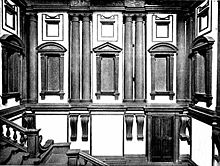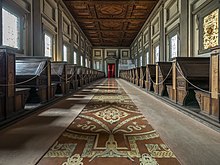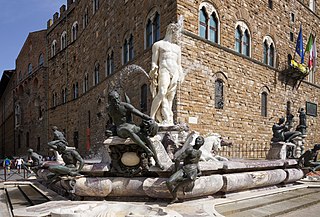
Bartolomeo Ammannati was an Italian architect and sculptor, born at Settignano, near Florence, Italy. He studied under Baccio Bandinelli and Jacopo Sansovino and closely imitated the style of Michelangelo.

Michelangelo di Lodovico Buonarroti Simoni, known mononymously as Michelangelo, was an Italian sculptor, painter, architect, and poet of the High Renaissance. Born in the Republic of Florence, his work was inspired by models from classical antiquity and had a lasting influence on Western art. Michelangelo's creative abilities and mastery in a range of artistic arenas define him as an archetypal Renaissance man, along with his rival and elder contemporary, Leonardo da Vinci. Given the sheer volume of surviving correspondence, sketches, and reminiscences, Michelangelo is one of the best-documented artists of the 16th century. He was lauded by contemporary biographers as the most accomplished artist of his era.
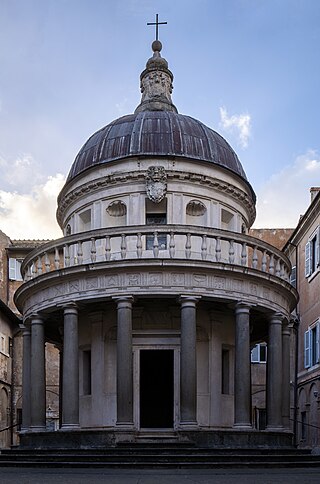
Renaissance architecture is the European architecture of the period between the early 15th and early 16th centuries in different regions, demonstrating a conscious revival and development of certain elements of ancient Greek and Roman thought and material culture. Stylistically, Renaissance architecture followed Gothic architecture and was succeeded by Baroque architecture. Developed first in Florence, with Filippo Brunelleschi as one of its innovators, the Renaissance style quickly spread to other Italian cities. The style was carried to other parts of Europe at different dates and with varying degrees of impact.

Filippo di ser Brunellesco di Lippo Lapi, commonly known as Filippo Brunelleschi and also nicknamed Pippo by Leon Battista Alberti, was an Italian architect, designer, goldsmith and sculptor. He is considered to be a founding father of Renaissance architecture. He is recognized as the first modern engineer, planner, and sole construction supervisor. In 1421, Brunelleschi became the first person to receive a patent in the Western world. He is most famous for designing the dome of the Florence Cathedral, and for the mathematical technique of linear perspective in art which governed pictorial depictions of space until the late 19th century and influenced the rise of modern science. His accomplishments also include other architectural works, sculpture, mathematics, engineering, and ship design. Most surviving works can be found in Florence.
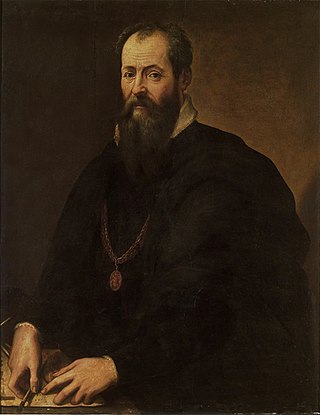
Giorgio Vasari was an Italian Renaissance painter and architect, who is best known for his work Lives of the Most Excellent Painters, Sculptors, and Architects, considered the ideological foundation of all art-historical writing, and still much cited in modern biographies of the many Italian Renaissance artists he covers, including Leonardo da Vinci and Michelangelo, although he is now regarded as including many factual errors, especially when covering artists from before he was born.

Santa Maria Novella is a church in Florence, Italy, situated opposite, and lending its name to, the city's main railway station. Chronologically, it is the first great basilica in Florence, and is the city's principal Dominican church.

The Basilica di Santa Croce is a minor basilica and the principal Franciscan church of Florence, Italy. It is situated on the Piazza di Santa Croce, about 800 metres southeast of the Duomo, on what was once marshland beyond the city walls. Being the burial place of some of the most notable Italians, such as Michelangelo, Galileo, Machiavelli, the poet Foscolo, the philosopher Gentile and the composer Rossini, it is also known as the Temple of the Italian Glories.

The Accademia di Belle Arti di Firenze is an instructional art academy in Florence, in Tuscany, in central Italy.

The Villa Giulia is a villa in Rome, Italy. It was built by Pope Julius III in 1551–1553 on what was then the edge of the city. Today it is publicly owned, and houses the Museo Nazionale Etrusco, a collection of Etruscan art and artifacts.
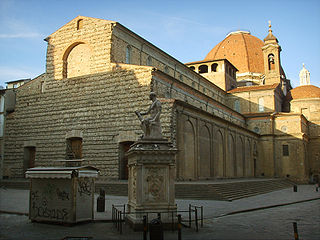
The Basilica di San Lorenzo is one of the largest churches of Florence, Italy, situated at the centre of the main market district of the city, and it is the burial place of all the principal members of the Medici family from Cosimo il Vecchio to Cosimo III. It is one of several churches that claim to be the oldest in Florence, having been consecrated in 393 AD, at which time it stood outside the city walls. For three hundred years it was the city's cathedral, before the official seat of the bishop was transferred to Santa Reparata.

Michelozzo di Bartolomeo Michelozzi was an Italian architect and sculptor. Considered one of the great pioneers of architecture during the Renaissance, Michelozzo was a favored Medici architect who was extensively employed by Cosimo de' Medici. He was a pupil of Lorenzo Ghiberti in his early years, and later collaborated with Donatello.

The Palazzo Vecchio is the town hall of Florence, Italy. It overlooks the Piazza della Signoria, which holds a copy of Michelangelo's David statue, and the gallery of statues in the adjacent Loggia dei Lanzi.
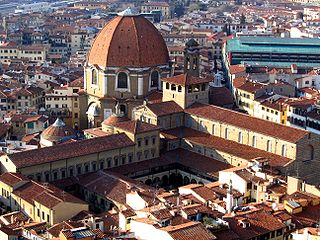
The Medici Chapels are two chapels built between the 16th and 17th centuries as an extension to the Basilica of San Lorenzo, in the Italian city of Florence. They are the Sagrestia Nuova, designed by Michelangelo, and the larger Cappella dei Principi, a collaboration between the Medici family and architects. The purpose of the chapels was to celebrate the Medici family, patrons of the church and Grand Dukes of Tuscany.

The Palazzo Medici, also called the Palazzo Medici Riccardi after the later family that acquired and expanded it, is a Renaissance palace located in Florence, Italy. It is the seat of the Metropolitan City of Florence and a museum.

Niccolò di Raffaello di Niccolò dei Pericoli, called "Il Tribolo" was an Italian Mannerist artist in the service of Cosimo I de' Medici in his natal city of Florence.
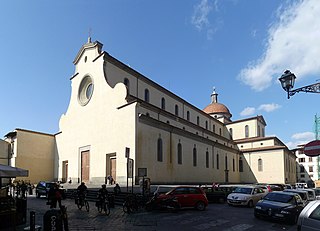
The Basilica di Santo Spirito is a church in Florence, Italy. Usually referred to simply as Santo Spirito, it is located in the Oltrarno quarter, facing the square with the same name. The interior of the building – internal length 97 m (318 ft) – is one of the preeminent examples of Renaissance architecture.

The New Michael Palace was the third Saint Petersburg palace designed by Andrei Stackenschneider for Nicholas I's children. It was built between 1857 and 1862 on the Palace Embankment, between the Hermitage Museum buildings and the Marble Palace.
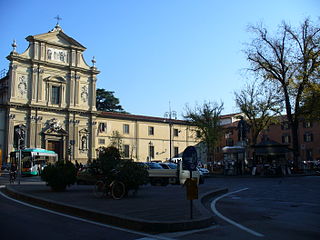
Museo Nazionale di San Marco is an art museum housed in the monumental section of the medieval Dominican convent of San Marco dedicated to St Mark, situated on the present-day Piazza San Marco, in Florence, a region of Tuscany, Italy.

The art collection of Holkham Hall in Norfolk, England, remains very largely that which the original owner intended the house to display; the house was designed around the art collection acquired by Thomas Coke, 1st Earl of Leicester, during his Grand Tour of Italy during 1712–18. To complete the scheme it was necessary to send Matthew Brettingham the younger to Rome between 1747 and 1754 to purchase further works of art.
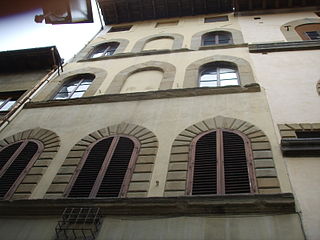
The Casa Vasari is a building at 8 borgo Santa Croce in Florence, previously the residence in that city of the painter, art historian and architect Giorgio Vasari. It preserves a valuable cycle of frescoes in the hall, conceived and created by Vasari with the help of pupils.


